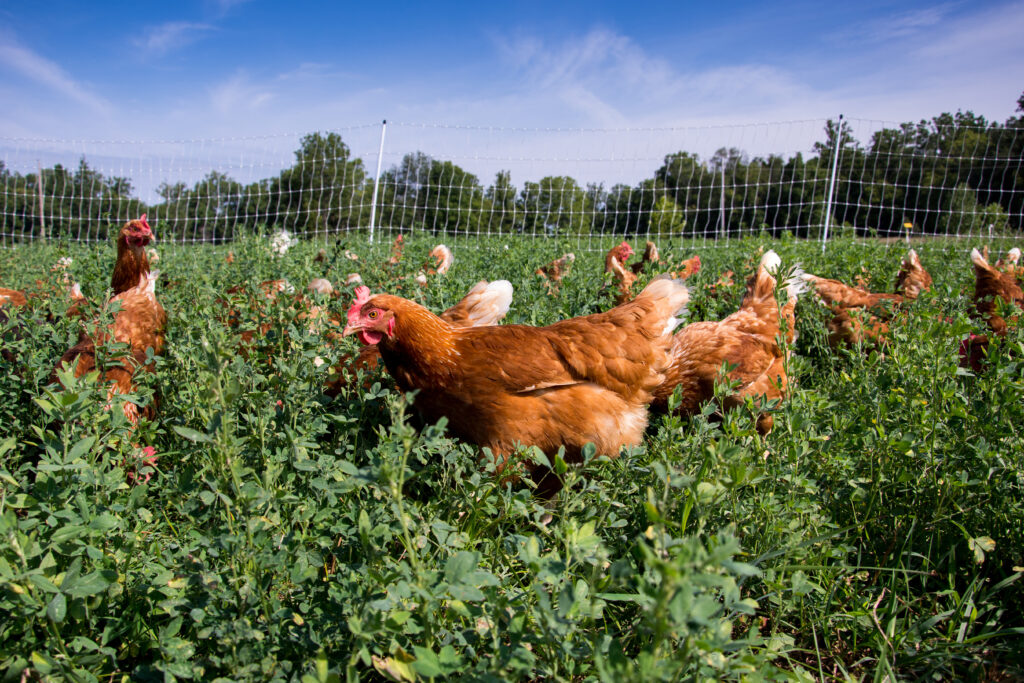
This post may contain affiliate links to our partners like Chewy, Amazon, and others. Purchasing through these helps us further the A-Z Animals mission to educate about the world’s species.
Red star chickens go by many names; for example, golden comet and sex-link, depending on the chickens used, breeder, and hatchery. These chickens were initially developed in the 1950s to use for production. Therefore they are found in large-scale commercial operations alongside the famous Leghorn chicken. However, hybrid chickens were frowned upon before the age of large egg-producing companies. But, the red star broke this stereotype and paved the way for novelty chickens with incredible egg-producing abilities and other distinctive characteristics that farmers desired.
Red Star Chicken History
Red stars were first developed in the 20th century due to the high demand for eggs in America. Unfortunately, small backyard breeders couldn’t keep up with the intense pressure for eggs, and commercial producers soon took over. However, the red star changed everything as they could produce eggs regularly and consistently to meet the massive demand.
The initial red star chickens were bred by crossing several breeds. However, the most common combinations were the Rhode Island white hen and the Rhode Island Red rooster. Other breeds included white Plymouth rocks and Delawares. That is why the red star has so many different names. For example:
- Red sex links
- Golden buffs
- Golden comets
- Golden sex links
- ISA Browns
- Cinnamon Queens
Red Star Chicken Amazing Facts
- Red star chickens result from crossbreeding two different breeds. For example, the ISA Brown is a combination of Rhode Island red roosters and white Plymouth rocks.
- Red stars are incredible escape artists who love to spread their wings and take flight. However, they will try to fly the coop. Therefore, ensure you have very tall fences.
- These hybrids are hardy and can survive in any climate. In addition, they generally lay eggs all year round, including during winter.
Red Star Chicken Scientific Name
The red star’s scientific name is Gallus gallus domesticus, which belongs to the order Galiformes, which consists of fowl or chicken-like birds. Additionally, this order contains 290 species, including the following:
Red star chickens are members of the Phasianidae, consisting of 214 species over 50 genera, making it a very diverse group. For example, members of this family include birds like francolin, grouse, turkey, Old World quail, partridge, and grouse.
Red Star Chicken Size, Appearance & Behavior
The red star chicken is classified as a sex-link breed due to the male and female chicks differing in color, which means it is really easy to determine the sex shortly after they hatch. Female chicks are a reddish color, while male chicks are light yellow with black specks. Therefore, these chickens are ideal additions to any backyard farms because farmers don’t have to stress about an incognito rooster amongst the hens, which is incredibly beneficial. However, red stars also have disadvantages. For example, because they are a sex-link breed, breeding true is not an option, meaning the offspring of a red star rooster and red star hen won’t coincide with the breed standard. To maintain the standard, farmers need to crossbreed the red stars with chickens like:
- Rhode Island whites
- Rhode Island reds
- White Plymouth rocks
- Delawares
Both male and female adult red stars are light brownish red to a rust color. In addition, there might be a variation in the feather’s coloration due to some black or white appearing. Hens and roosters both have yellow beaks and legs and single combs.
These chickens are cleaned legged, meaning they don’t have any feathers on their legs. Both sexes weigh between six to eight pounds once they are fully mature. Therefore, they make excellent meat birds and laying hens.
Due to male and female chicks varying in color, it is very convenient to identify the roosters, and since they cannot breed true, males are typically removed from the coop once they have been discovered.

©Tony Campbell/Shutterstock.com
Behavior
It’s tough to determine the red star’s behavior because it varies significantly due to this chicken stemming from different breeds. So, when purchasing several red stars, expect a bouquet of personalities as they begin to mature. Therefore, it’s best to ask your breeder what birds they used to produce your chicks. Although their behavior differs a lot, one thing they have in common is they are docile towards humans but can be aggressive with flockmates. This means that it’s easier to add red stars to your current flock than to introduce new breeds to a community of red stars. In addition, another trait of theirs is their desire to fly, and surprisingly, they are actually quite good at it. However, they are not endurance flyers but will be able to get over a regular fence. Additionally, they prefer flying to high roosts and perches. That’s why it is so important to have high fences when housing these birds.
Red Star Chicken Diet
The red star is an exemplary forager, but owners are still required to provide additional nutrition from a range of foods to ensure they remain healthy. This especially applies to the hens, who need more calcium to lay large eggs. Therefore, buying high-quality commercial poultry feed is essential and must be the primary food source in their diets. Poultry feed generally consists of:
- Grains like corn, oats, and soybeans
- Grit like ground oyster shell or limestone
- Vitamins like calcium
Poultry feed comes in three forms, mash, crumbed, or pellet.
While these feeds contain calcium, they might not have enough to meet the needs of laying hens and could result in malformed or paper-thin eggs. But, owners can add extra calcium to their red stars’ diets by feeding them shelled oysters which contain high amounts of calcium, resulting in stronger eggs.
In addition to high-quality feed, red stars need several fruits and vegetables daily. However, not all fruit and veg are good for these chickens, and owners need to be careful as red stars will eat pretty much anything. Produce that is beneficial to these chickens includes:
- Spinach
- Carrot
- Banana
- Silverbeet
- Berries
- Apple
- Cabbage
- Broccoli
You can also treat your chickens to foods like cooked pasta, bread, and cooked rice, but in moderation. In addition, you can also feed your red stars leftovers as long as you avoid giving them anything with raw potatoes, uncooked beans, uncooked rice, garlic, chocolate, citrus fruits, avocado, and apricots. Also, never feed them spoiled food or foods with a high fat and salt content.
Red Star Chicken Predators and Threats
Sadly, chickens aren’t very high on the food chain and fall prey to numerous predators looking for their next meal. Unfortunately, predators can prey on these chickens in suburban, urban, and rural areas. However, this shouldn’t deter you from raising chickens; there are ways to keep them protected from predators; you just need to get a little creative. For example, most predators hunt at night as they can move more freely in darkness. When last have you seen an opossum, raccoon, weasel, fisher cat, wolf, or coyote during the day? So, chickens must always be locked up in a coop with latches at night. Ensure you choose locks or latches that even the sliest raccoon can’t pry open.
Additionally, vents or windows must be covered by ½ an inch of welded wire to ensure that even the smallest weasel cannot gain access. Whatever you do, do not use chicken wire to cover any openings, as raccoons and other animals can chew through it. Lastly, you can repel any predators by installing solar-powered blinking lights around the coop, as wild animals usually think red lights are the eyes of more intimidating predators.
Red Star Chicken Reproduction, Eggs, and Lifespan
As mentioned above, the red star can’t breed true, so you have to crossbreed them with other breeds like white rocks, Delawares, and white Plymouth rocks. Never let a red star rooster mate with a red star hen, as they will not meet the breed standard.
Eggs
Red stars might excel at laying eggs; they are not broody, which means hens don’t usually incubate their eggs to help them hatch. Therefore, if you are raising these chickens, it’s best to get an egg incubator. Alternatively, another option is having a different breed of hen that does sit on eggs. However, red stars’ lack of broodiness can also be a positive because they are one of the few chickens you can use at maximum capacity. For example, fewer chicks to hatch results in higher egg production.
Red star hens start laying eggs before they turn a year old, usually between 18 to 22 weeks of age. As long as these hens receive a nutritious diet and are housed in the right conditions, they will lay plenty of eggs for their owners. For example, they can lay between 280 and 360 eggs annually. However, they average 300 eggs per year. Therefore, you can expect around four to five eggs weekly per hen, and if owners care for them very well, they might even lay an egg a day. In addition, their eggs are large and brown.
People can usually determine what color a chicken’s eggs will be by the color of its earlobes. So, if they have red earlobes, they generally lay brown eggs, and if they have white earlobes, their eggs will usually be white. However, there are a few exceptions. But, there is no difference in flavor between the two colors; what will influence the taste of the egg is the chicken’s diet.
Red Star Chicken Population
Unfortunately, there is no information on the population size of red stars, but since they are used for commercial purposes, there are a lot of farmers that raise red stars, so it’s safe to say they are not threatened at the moment.
Raising Red Star Chickens
Red stars are incredibly hardy and can survive in various climates. However, their combs are prone to frostbite in colder temperatures. This is entirely avoidable by coating their combs in Vaseline.
Because red stars are avid foragers, they make excellent free-range chickens, making them perfect for smaller farms and backyards. Additionally, by allowing these hens to forage, they can catch food that provides them with extra calcium and protein, which is essential to promote high egg production. However, they will require indoor shelter to hide from bad weather (cold or hot) and predators. Lastly, ensure the coop always has food, fresh water, clean nesting materials, and a net over the top to ensure your red stars don’t fly away.
Up Next
View all 110 animals that start with R
Red stars can lay between 280 and 360 eggs annually. However, they average 300 eggs per year.
Red stars are used for meat and egg production.
The initial red star chickens were bred by crossing several breeds. However, the most common combinations were the Rhode Island white hen and the Rhode Island Red rooster. Other breeds included white Plymouth rocks and Delawares.
link







